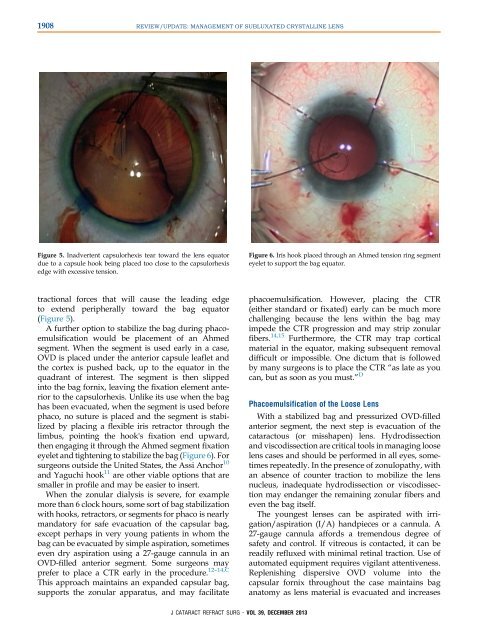Management of Subluxated Lens
Management of Subluxated Lens
Management of Subluxated Lens
Create successful ePaper yourself
Turn your PDF publications into a flip-book with our unique Google optimized e-Paper software.
1908 REVIEW/UPDATE: MANAGEMENT OF SUBLUXATED CRYSTALLINE LENS<br />
Figure 5. Inadvertent capsulorhexis tear toward the lens equator<br />
due to a capsule hook being placed too close to the capsulorhexis<br />
edge with excessive tension.<br />
Figure 6. Iris hook placed through an Ahmed tension ring segment<br />
eyelet to support the bag equator.<br />
tractional forces that will cause the leading edge<br />
to extend peripherally toward the bag equator<br />
(Figure 5).<br />
A further option to stabilize the bag during phacoemulsification<br />
would be placement <strong>of</strong> an Ahmed<br />
segment. When the segment is used early in a case,<br />
OVD is placed under the anterior capsule leaflet and<br />
the cortex is pushed back, up to the equator in the<br />
quadrant <strong>of</strong> interest. The segment is then slipped<br />
into the bag fornix, leaving the fixation element anterior<br />
to the capsulorhexis. Unlike its use when the bag<br />
has been evacuated, when the segment is used before<br />
phaco, no suture is placed and the segment is stabilized<br />
by placing a flexible iris retractor through the<br />
limbus, pointing the hook's fixation end upward,<br />
then engaging it through the Ahmed segment fixation<br />
eyelet and tightening to stabilize the bag (Figure 6). For<br />
surgeons outside the United States, the Assi Anchor 10<br />
and Yaguchi hook 11 are other viable options that are<br />
smaller in pr<strong>of</strong>ile and may be easier to insert.<br />
When the zonular dialysis is severe, for example<br />
more than 6 clock hours, some sort <strong>of</strong> bag stabilization<br />
with hooks, retractors, or segments for phaco is nearly<br />
mandatory for safe evacuation <strong>of</strong> the capsular bag,<br />
except perhaps in very young patients in whom the<br />
bag can be evacuated by simple aspiration, sometimes<br />
even dry aspiration using a 27-gauge cannula in an<br />
OVD-filled anterior segment. Some surgeons may<br />
prefer to place a CTR early in the procedure. 12–14,C<br />
This approach maintains an expanded capsular bag,<br />
supports the zonular apparatus, and may facilitate<br />
phacoemulsification. However, placing the CTR<br />
(either standard or fixated) early can be much more<br />
challenging because the lens within the bag may<br />
impede the CTR progression and may strip zonular<br />
fibers. 14,15 Furthermore, the CTR may trap cortical<br />
material in the equator, making subsequent removal<br />
difficult or impossible. One dictum that is followed<br />
by many surgeons is to place the CTR “as late as you<br />
can, but as soon as you must.” D<br />
Phacoemulsification <strong>of</strong> the Loose <strong>Lens</strong><br />
With a stabilized bag and pressurized OVD-filled<br />
anterior segment, the next step is evacuation <strong>of</strong> the<br />
cataractous (or misshapen) lens. Hydrodissection<br />
and viscodissection are critical tools in managing loose<br />
lens cases and should be performed in all eyes, sometimes<br />
repeatedly. In the presence <strong>of</strong> zonulopathy, with<br />
an absence <strong>of</strong> counter traction to mobilize the lens<br />
nucleus, inadequate hydrodissection or viscodissection<br />
may endanger the remaining zonular fibers and<br />
even the bag itself.<br />
The youngest lenses can be aspirated with irrigation/aspiration<br />
(I/A) handpieces or a cannula. A<br />
27-gauge cannula affords a tremendous degree <strong>of</strong><br />
safety and control. If vitreous is contacted, it can be<br />
readily refluxed with minimal retinal traction. Use <strong>of</strong><br />
automated equipment requires vigilant attentiveness.<br />
Replenishing dispersive OVD volume into the<br />
capsular fornix throughout the case maintains bag<br />
anatomy as lens material is evacuated and increases<br />
J CATARACT REFRACT SURG - VOL 39, DECEMBER 2013


